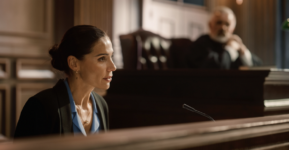Tips For Testifying in Court as a Witness

Receiving a subpoena to attend court as a witness can be nerve-wracking, particularly if all you know about giving evidence – also known as ‘testifying’ – is from courtroom dramas where a lawyer eviscerates a hapless person on the stand while onlookers pass judgment.
But while giving evidence may seem daunting, understanding a little about the process and what may be required of you can make the experience a lot easier to deal with.
So, here’s a basic outline of the system as well as a few tips for attending as a witness.
Understanding The Adversarial System
In Australia, Local Court defended hearings as well as District and Supreme Court jury and judge-alone trials for criminal cases are run under adversarial model, where two opposing parties “battle it out” in court.
On the one hand, prosecutors – such as police prosecutors in the Local Court and Crown prosecutors in the higher courts – act on behalf of the State. Their role is not to get a conviction at all costs but, rather, to present all of the admissible evidence that is available with a view to advancing the interests of justice.
On the other are criminal defence lawyers, whose role it is to act in the interests of their clients – who are called defendants or accused persons – with a view to putting the prosecution to proof (in other words, ensuring requiring they prove all essential elements of the offence that is charged), challenging the prosecution evidence and presenting the case for the defence which can included eliciting evidence from defence witnesses and available legal defences. Their ultimate goal is to raise reasonable doubt regarding the commission of the alleged offence.
As a witness, you could be called by the prosecution or the defence, and the party by which you are summonsed will normally be the first one to ask you questions.
The examination of witnesses by lawyers has three distinct steps:
Examination in chief
This is where a party calls their witness and asks a series of open-ended questions.
The lawyer has to be careful not to use “leading questions” (questions which put words in your mouth), and they will allow you to give testimony at your own pace, in your own way.
Cross-examination
This is where the opposing party asks questions designed to test the accuracy of witness testimony or to establish facts which support the other side. Lawyers in cross-examination are allowed to ask leading questions and they may be more abrupt and rapid in their approach.
Re-examination
This is where the original party who called the witness is able to ask questions relating to matters which arose during cross-examination.
This will occur if something raised in cross-examination is of concern.
Taking An Oath or Affirmation
Before entering the witness box, you will be asked to make a verbal promise to the court to tell the truth in your testimony.
There are two versions of this promise: an “oath” which references God, and an “affirmation” which is a secular alternative.
If you are taking an oath, you will be asked to hold a Bible (or another religious text) and state out loud:
“I swear by Almighty God that the evidence I shall give will be the truth, the whole truth, and nothing but the truth“.
If you are taking an affirmation, you be asked to state out loud:
“I solemnly declare and affirm that the evidence I shall give will be the truth, the whole truth, and nothing but the truth”
This is more than a symbolic gesture, breaking an oath or affirmation to the court promising to tell the truth could amount to the offence of perjury.
Surviving Cross-Examination
Witnesses are often most concerned about cross-examination, stirring up worries they will be forced to say something that is untrue or will have their character attacked.
It’s important to see cross-examination as part of the “theatre” of the adversarial trial, rather than any personal attack on you as a person.
Lawyers cross-examining you may put questions you in a rapid pace or using a blunt. This style is designed to make witnesses feel under pressure in the moment, but you don’t have to fall for it. There is no need to “mirror” the tone or pacing of questions in cross-examination. You should take all the time you need to give your testimony as accurately as possible.
As leading questions in cross-examination are allowed, it’s often easiest to give your evidence as a simply “yes” or “no”. However, if you need articulate your response in full, you should feel free to do so. Your role is to inform the court with as much relevant information as possible.
It’s worth noting that the vast majority of cross-examinations are boring affairs, with a handful of questions put to the witness. As long as you answer each question truthfully, you don’t have much to worry about.
Tips
Here are a few general tips to help when you’re called to the stand:
- Understand your relevance: whilst you won’t know for sure what you will be asked in the witness box, generally questions will focus on something you have seen or heard. You may have given a police statement or spoke to the lawyers about an event. Understanding your relevance can help you mentally prepare for what you’re going to be asked.
- Don’t worry about objections: movies and TV-shows have given undue emphasis on lawyers jumping up to object to witness testimony. Whilst it’s absolutely possible that a lawyer may object to part of your testimony, it is not for you to understand and anticipate the rules of evidence. Listen and follow directions by the lawyer calling you or the judge when it comes to inadmissible evidence, but leave most of this concern to the lawyers!
- Ask for clarification, but don’t “play dumb”: if you’re genuinely unsure about a question you should ask for it to be clarified. However, it is very poor form to pretend that you don’t understand a question simply to hinder the process of cross-examination.
- Dress formally: although there is no strict dress code for being a witness in court, the general expectation is that you dress in business-attire or other appropriate formal clothes. This doesn’t just help you present better when giving evidence, it may give you a boost of confidence if you’re looking your best.
- Remember to breathe: don’t underestimate the usefulness of taking a nice, slow, deep breath whilst giving testimony. Slowing down your breathing is a proven way to calm your nerves in the moment, and also helps you take a moment before responding to a question.






